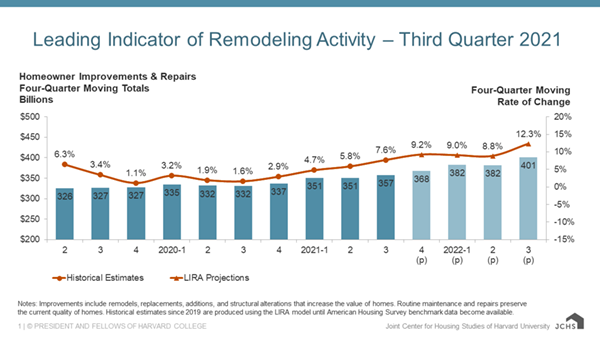Gains in Remodeling to Remain Robust

CAMBRIDGE, MA – Strong growth in home improvement and maintenance expenditures is expected to continue over the coming year, according to the Leading Indicator of Remodeling Activity (LIRA) released today by the Remodeling Futures Program at the Joint Center for Housing Studies of Harvard University. The LIRA projects year-over-year gains in annual improvement and repair spending will reach 9 percent in the fourth quarter and maintain that pace into 2022.
“Residential remodeling continues to benefit from a strong housing market with elevated home construction and sales activity and immense house price appreciation in markets across the country,” says Carlos Martín, Project Director of the Remodeling Futures Program at the Center. “The rapid expansion of owners’ equity is likely to fuel demand for more and larger remodeling projects into next year.”
“With these tailwinds, annual improvement and repair expenditures by homeowners could reach $400 billion by the third quarter of 2022,” says Abbe Will, Associate Project Director of the Remodeling Futures Program. “Yet there are several headwinds that could still taper the expected growth in remodeling spending including the rising costs of labor and building materials, as well as increasing interest rates.”
A year after the unprecedented changes to the US economy brought on by the pandemic, many economic indicators are showing extreme percent changes from pandemic-induced lows. To reduce the enormous growth rate volatility generated by these year-over-year comparisons, the projections for 2022-Q2 and -Q3 utilize smoothed data for three leading model inputs: residential remodeling permits, single-family housing starts, and existing single-family home sales. Using unsmoothed inputs in the LIRA model would have projected unlikely annual growth rates roughly two-thirds larger than reported. The Remodeling Futures Program will continue to monitor input volatility.
Click image for full-size chart.
The Leading Indicator of Remodeling Activity (LIRA) provides a short-term outlook of national home improvement and repair spending to owner-occupied homes. The indicator, measured as an annual rate-of-change of its components, is designed to project the annual rate of change in spending for the current quarter and subsequent four quarters, and is intended to help identify future turning points in the business cycle of the home improvement and repair industry. Originally developed in 2007, the LIRA was re-benchmarked in April 2016 to a broader market measure based on the biennial American Housing Survey.
The LIRA is released by the Remodeling Futures Program at the Joint Center for Housing Studies of Harvard University in the third week after each quarter’s closing. The next LIRA release date is January 20, 2022.
The Remodeling Futures Program, initiated by the Joint Center for Housing Studies in 1995, is a comprehensive study of the factors influencing the growth and changing characteristics of housing renovation and repair activity in the United States. The Program seeks to produce a better understanding of the home improvement industry and its relationship to the broader residential construction industry.
The Harvard Joint Center for Housing Studies advances understanding of housing issues and informs policy. Through its research, education, and public outreach programs, the Center helps leaders in government, business, and the civic sectors make decisions that effectively address the needs of cities and communities. Through graduate and executive courses, as well as fellowships and internship opportunities, the Center also trains and inspires the next generation of housing leaders.
Contact: Kerry Donahue, (617) 495-7640, [email protected]

